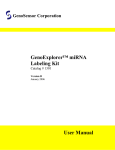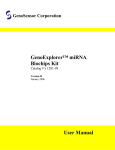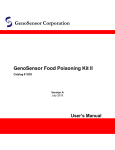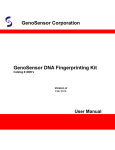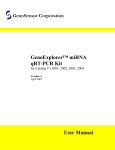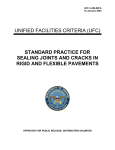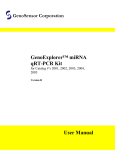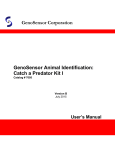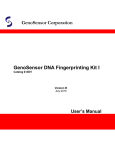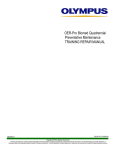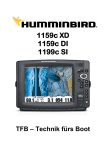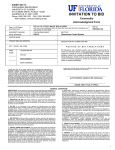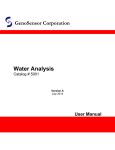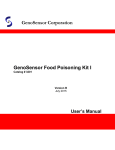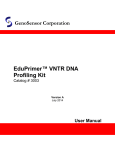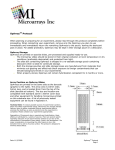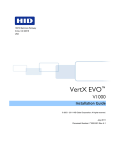Download User`s manual - GenoSensor Corporation
Transcript
GenoSensor Corporation GenoExplorer™ miRNA Labeling Kit Catalog # 1301,1302 Version C June 2009 User Manual GenoExplorer™ microRNA Labeling Kit Table of Contents Product Overview………………………………………………………………………...... 2 Kit Components and Storage Condition….………………………………………………... 3 Additional Required Materials……………........................................................................... 4 Related Products from GenoSensor....................................................................................... 4 GenoExplorer™ miRNA Labeling Protocol .........................................................................5 GenoExplorer™ labeled miRNA Hybridization Assay Guidelines.......................................7 Appendix .............................................................................................................................. 8 Troubleshooting..................................................................................................................... 8 Technical Service................................................................................................................... 10 Literature Citation When describing a procedure for publication using these products, we would appreciate that you refer to them as the GenoExplorer™ miRNA Labeling Kit and the GenoExplorer™ miRNA Biochips Kit. Patents and Trademarks GenoExplorer is a trademark of GenoSensor. The GenoExplorer™ miRNA Labeling Kit and the GenoExplorer™ miRNA Biochips Kit are covered by patents pending. 1 GenoExplorer™ microRNA Labeling Kit Product Overview The GenoExplorer™ miRNA Labeling Kit • Selective and Uniform Labeling GenoExplorer™’s labeling system employs a 5’end ligation approach. This offers greater selectivity in the labeling of RNA compared with more traditional 3’ approaches since RNA molecules with capped 5’ ends (e.g., intact mRNA) will not be labeled. The ligation reaction also ensures that the labeling is uniform in that a single adaptor is attached to each RNA molecule with an uncapped 5’end. GenoExplorer™ currently offers a biotin label. • Simplified Sample Prep Protocol With GenoExplorer™’s more selective labeling system, RNA samples do not require the additional miRNA/small RNA isolation step as some labeling protocols recommend. Users can begin their labeling reaction with total RNA. It is important, however, to ensure that small RNA is retained during the initial RNA extraction procedure. • Streptavidin-Dye Staining The GenoExplorer™ full kit also includes a streptavidin-dye conjugate which is used for the post-hybridization dye staining step. This step is required for RNA labeled with biotin. 2 GenoExplorer™ microRNA Labeling Kit Kit Components and Storage Conditions GenoExplorer™ miRNA Full Kit for 20 or 4 Reactions Components Buffer L Enzyme L SA-S Dye Buffer S User’s Manual 20 Reaction Amount 140 µl 10 µl 20 µl 2 vials of 1.4 ml each Web download 4 Reaction Amount 28 µl 2 µl 5 µl 0.56 ml Web download Storage -20º C -20º C -20º C -20º C Shipping and Storage GenoExplorer™ miRNA Labeling Kit reagents are shipped on dry ice. Components should be stored at temperatures shown in the above table. At proper storage conditions, components are stable for 1 year from the date received. Expiration dates are also noted on product labels. Safety Warnings and Precautions For research use only. Not recommended or intended for the diagnosis of disease in humans or animals. Do not use internally or externally in humans or animals. Consider all chemicals as potentially hazardous. Only persons trained in laboratory techniques and familiar with the principles of good laboratory practice should handle these products. Wear suitable protective clothing such as laboratory overalls, safety glasses, and gloves. Exercise caution to avoid contact with skin or eyes: if contact should occur, wash immediately with water (Material Safety Data Sheet for products is available upon request). 3 GenoExplorer™ microRNA Labeling Kit Additional Required Materials Recommended: GenoExplorer™ miRNA Biochips Kit Recommended: GenoExplorer™ miRNA Probe Set Recommended: GenoExplorer™ Reagents for Hybridization Assay Total RNA containing the small RNA RNase-free water Adjustable pipettors RNase-free tips RNase-free polypropylene microcentrifuge tubes (0.2, 0.5 or 1.5 ml) Graduated cylinder Microcentrifuge Incubator set at 37º C Incubator or heating block set at 75º Heating block at 95º C Hybridization Station (optional), for automated hybridization (e.g., Genomic Solutions, Tecan) or Coverslips, for manual hybridization (e.g., Erie LifterSlips™ , Product # 22x30I-2-4374) Slide Chamber, for manual hybridization (e.g., Corning® Microarray Hybridization Chamber, Product #2551) Incubator or water bath set at 42º C, for manual hybridization Bottles for storing diluted Wash Buffers Centrifuge or air blower Microarray scanner (e.g., Axon, Agilent, Parkard) and image processing software Several wash containers appropriately sized to the number of chips being used Related Products from GenoSensor GenoExplorer™ microRNA Full Kit (Cat# 1101C – 1199C) GenoExplorer™ microRNA Biochips Kit (Cat# 1201C – 1299C) GenoExplorer™ microRNA Probe Set (Cat# 1401C – 1499C) GenoExplorer™ Reagents for Hybridization Assay (Cat# 1500’s) 4 GenoExplorer™ microRNA Labeling Kit GenoExplorer™ Labeling Protocol General Description The GenoExplorer™ miRNA Labeling Kit (patent pending) provides a direct endlabeling method. Biotin labels are ligated to the 5’ ends of RNA molecules which do not contain a 5’-capped structure. These RNA molecules include rRNA, tRNAs, regulatory small RNAs such as microRNA, siRNA, snRNAs, and other RNA transcripts of yet unknown function. Due to labeling selectivity, this method has resulted in low false positive hybridization signals that are usually caused by mRNA, which are the most highly complex sequences of genome transcripts. This protocol uses directly isolated RNA without RNA target amplification, and ultimately reflects the cellular microRNA molar ratio, thus providing for the reliability of hybridization signals. The streptavidinconjugated dye stain (SA-S Dye) and the staining buffer (Buffer S) reagents are also included in this kit. Their preparation and use in the post-hybridization staining procedure is described below in the hybridization assay section. Handling RNA Samples When working with RNA, always use proper microbiological aseptic techniques. Use RNase- and DNase-free reagents, water, glassware and plasticware. Use non-powdered gloves during all steps of sample labeling, chip hybridization, washing, detection, and scanning. RNA Preparation The GenoExplorer™ miRNA Labeling Kit (patent pending) provides an easy and quick way to label microRNAs and other small RNAs. Total RNA isolation (not provided) using traditional methods such as Trizol is recommended. Some commercial kits can be used. Users should be aware of the harvest efficiency for small RNAs when choosing them. Checking with manufacturers is highly recommended. A total RNA starting amount of 5 to 10 micrograms is recommended. High quality and sufficient amounts of RNA samples is crucial for experiments with microarrays. RNA quality can be evaluated by visualizing the RNA on a gel, as well as by calculating the A260/A280 ratio. On a denaturing gel (or on an ordinary agarose gel in denaturing buffer) the RNA should appear as two bright distinct bands that represent the 28S and 18S ribosomal species. The 28S band should be brighter than the 18S band. Tailing of these major bands down the gel, or a background smear behind these bands that gets heavier at lower molecular weights can indicate degradation of the RNA. Degraded RNA will produce high background and low signal intensity microarray results. 5 GenoExplorer™ microRNA Labeling Kit miRNA Labeling Procedure This procedure is used to attach a biotin label to the 5’ ends of RNA molecules. 1. Place Buffer L on ice and thaw for 15-20 minutes. Check for any precipitate. If necessary, warm the solution to 37°C and agitate to dissolve the precipitate completely. Note: Aliquot is recommended to minimize thaw/freeze cycles 2. Mix Buffer L by vortexing followed by brief centrifugation. 3. Combine reagents according to Table 1 below for a single reaction. Reagents should be combined in an RNAase-free microcentrifuge tube and all reagents should be kept on ice during set up of the reaction. For high accuracy, pipet the viscous Buffer L slowly. Table 1: miRNA Labeling Reaction Mix Reagents Volume (µl) Buffer L 7.0 Adjustable RNA (2.5-10µg) RNAase-free water Adjustable Enzyme L 0.5 Total 20 4. 5. 6. 7. Mix reaction thoroughly by pipetting up and down several times. Incubate at 20º C for 3 hours. Incubate at 75º C for 20 min to inactivate the enzyme. Store on ice until ready for the hybridization step. The labeled sample can also be stored at -70º C and used later. 6 GenoExplorer™ microRNA Labeling Kit GenoExplorer™ Labeled miRNA Hybridization Assay Guidelines The GenoExplorer™ miRNA Labeling Kit has been optimized for microarray experiments using GenoExplorer™ microRNA chips and assay reagents. If microarrays other than GenoExplorer™ microRNA chips are used, consult the optimized protocols established by the microarray/probe set provider. However, it is critical to also include the post-hybridization staining step. Below are general guidelines that can be used for running the hybridization assay using GenoExplorer™ miRNA labeled samples. For a detailed protocol on running GenoExplorer™ labeled miRNA on GenoExplorer™ BioChips, please consult the user manual for the GenoExplorer™ full kit. 1. Prepare labeled RNA in hybridization buffer following the optimized protocol established by microarray/probe set provider. 2. Incubate the sample at 90-95º C for 5 min to denature. 3. Cool sample by spinning down briefly. 4. Hybridize samples on microarrays following the optimized protocols established by the microarray and/or probe set provider. 5. After completion of the hybridization, slides should be washed and dried according to optimized protocols established by the microarray and/or probe set provider. If hybridization is performed in an automated hybstation, the drying step is probably not required. 6. Within 15 minutes of beginning the post-hybridization staining, the SA-S dye should be diluted 250-fold into Buffer S. For a single sample this dilution should be performed by adding 1 µl of the SA-S to 249 µl of buffer S followed by gentle mixing and brief centrifugation. Keep protected from light to minimize photobleaching of dye. 7. Load the 1:250 diluted SA-S dye stain solution on to the array and incubate at 25ºC for 30 min. Shield the slide from light to minimize effects of photobleaching of the dye. 8. After completion of the post-hybridization staining step, slides should be washed and dried according to the optimized protocols established by the microarray and/or probe set provider. Scanning, Detection and Image Analysis Consult the scanner manufacturer instructions for laser and PMT settings. The SA-S dye stain signal can be detected using the scanner’s 635 nm wavelength (Cy5) channel. Consult the .gal file provided by the microarray manufacturer for further data analysis. 7 GenoExplorer™ microRNA Labeling Kit Appendix Troubleshooting Guide Poor Hybridization Signal Poor quality RNA samples Suboptimal amount of sample applied to microarray Improper detection strategy Signal lost by exposure to light, environmental conditions Poor biotin/ SA-S dye detection Hybridization signal “stripped” from microarray Suboptimal hybridization time • Use higher quality RNA samples • Use proper laboratory techniques when handling RNA samples • Label and hybridize more sample to microarray • Label and hybridize more sample to microarray • Verify that detection instrumentation is compatible with detection reagents • Adjust detection settings • Minimize exposure to light • Ensure that the samples have been purified and quantified properly before labeling • Ensure that the kit components have been stored properly • Ensure that the detection solution was prepared and stored properly • Ensure correct temperatures are used for each of the process steps. • Extend hybridization time 8 GenoExplorer™ microRNA Labeling Kit High Background Excess detection reagents remaining on microarray Excess sample applied to microarray Ink or marker used to identify microarray • Do not allow slides to dry out during hybridization protocol • Do not touch microarray directly or forcibly remove coverslip at any time • Quantify the amount of labeled sample and use less in hybridization • Avoid using markers or ink to identify slide; use a diamond scribe pen Dust Dust on microarray • Avoid dust from environment • Minimize exposure of the microarray to the air • Use filtered distilled water for final wash 9 GenoExplorer™ microRNA Labeling Kit Technical Service For more information or technical assistance, please call, write, fax, or email. GenoSensor Corporation 4665 S. Ash Avenue Suite G-18 Tempe, Arizona 85282 Tel: 1-480-598-5378 Fax: 1-480-755-3319 Email: [email protected] Web: www.genosensorcorp.com Limited Warranty GenoSensor is committed to providing our customers with high-quality goods and services. Our goal is to ensure that every customer is 100% satisfied with our products and our service. If you should have any questions or concerns about a GenoSensor product or service, please contact our Technical Service at [email protected]. GenoSensor warrants that all of its products will perform according to the specifications stated on the certificate of analysis. This warranty limits GenoSensor Corporation’s liability only to the cost of the product. No warranty is granted for products beyond their listed expiration date. No warranty is applicable unless all product components are stored in accordance with instructions. GenoSensor reserves the right to select the method(s) used to analyze a product unless GenoSensor agrees to a specified method in writing prior to acceptance of the order. GenoSensor makes every effort to ensure the accuracy of its publications, but realizes that the occasional typographical or other error is inevitable. Therefore GenoSensor makes no warranty of any kind regarding the contents of any publications or documentation. If you discover an error in any of our publications, please report it to our Technical Service. GenoSensor assumes no responsibility or liability for any special, incidental, indirect or consequential loss or damage whatsoever. The above limited warranty is sole and exclusive. No other warranty is made, whether expressed or implied, including any warranty of merchantability or fitness for a particular purpose. 10











